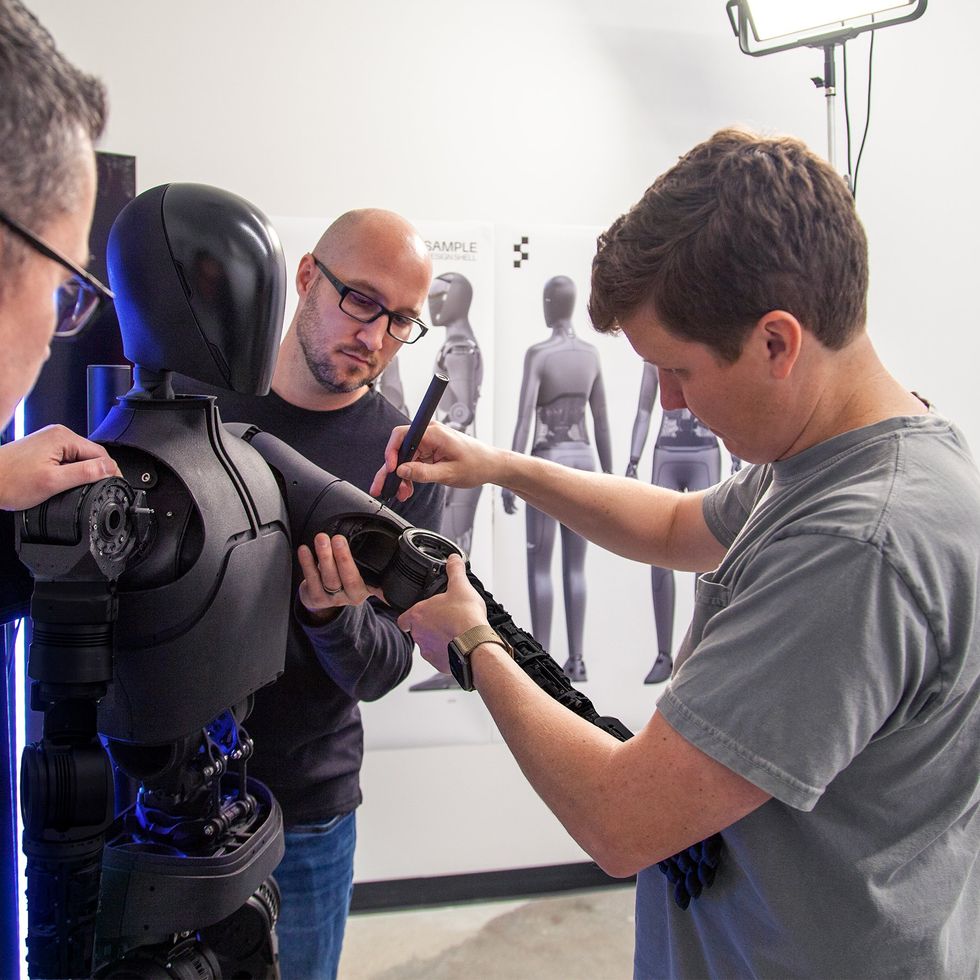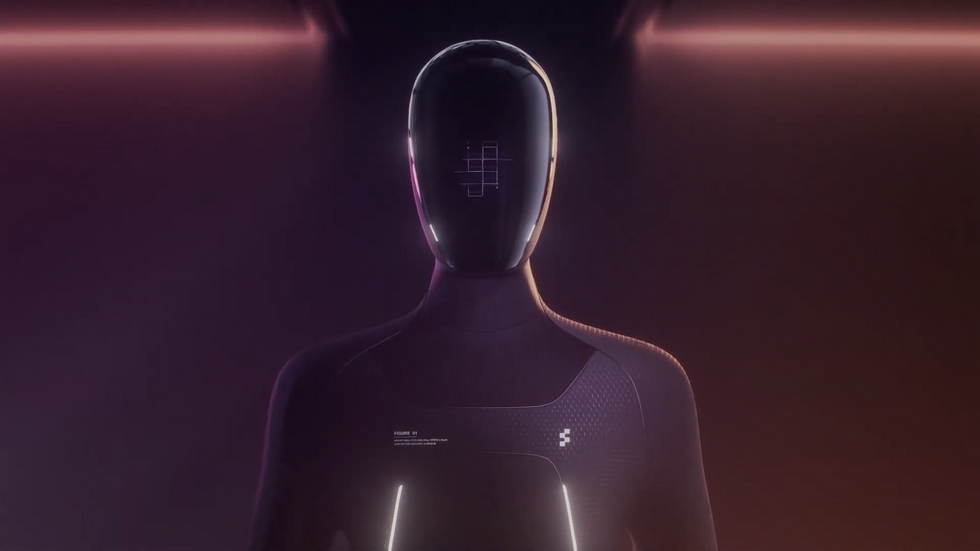Today, a robotics startup called Figure is unveiling “the world’s first commercially viable general purpose humanoid robot,” called Figure 01. Shown in the rendering above, Figure 01 does not yet exist, but according to this morning’s press release, it will “have the ability to think, learn, and interact with its environment and is designed for initial deployment into the workforce to address labor shortages and over time lead the way in eliminating the need for unsafe and undesirable jobs.” Which sounds great, when (or if) it happens.
We are generally skeptical of announcements like these, where a company comes out of stealth with ambitious promises and some impressive renderings but little actual hardware to demonstrate along with them. What caught our eye in Figure’s case is its exceptionally qualified robotics team, led by its chief technology officer, Jerry Pratt. Pratt spent 20 years at the Florida Institute for Human and Machine Cognition (IHMC), where he led the team that took second place at the DARPA Robotics Challenge Finals. Working with DRC Atlas, NASA’s Valkyrie, and most recently Nadia, IHMC has established itself as a leader in robot design and control. And if anyone is going to take a useful humanoid robot from an engineering concept to commercial reality, these are the folks to do it.
Figure was founded in 2022 by Brett Adcock, who also founded Archer Aviation, which has successfully built and is currently flight-testing a commercial passenger eVTOL aircraft. Over the past year, the company has hired more than 40 engineers from institutions that include IHMC, Boston Dynamics, Tesla, Waymo, and Google X, most of whom have significant prior experience with humanoid robots or other autonomous systems.
“It’s our view that this is the best humanoid robotics team out there,” Adcock tells IEEE Spectrum. “Collectively, the team has probably built 12 major humanoid robots,” adds CTO Pratt. “We’ll have expertise in just about every part of the thousands of things that you need to do for humanoids.” Pratt says that initially, Figure isn’t expecting to use much in the way of new technology with its robot—it’s not based around some secret actuator technology or anything like that. “It’ll be a new design, with really solid engineering.”
The commercially viable general-purpose humanoid robot that Figure is working toward is going to look something like this:
Obviously, the above video (and all of the robot images in this article) are renderings, and do not show a real robot doing real things. However, these renderings are based on a CAD model of the actual robot that Figure plans to build, so Figure expects that its final hardware will be very similar to what they are showing today. Which, if that’s how it ultimately turns out, will be impressive: it’s a very slim form factor, which does put some limits on its performance. The final robot will be fully electric, 1.6 meters tall, weigh 60 kilograms with a 20 kg payload, and run for 5 hours on a charge.

“Having a humanoid form—it’s really tough doing the packaging,” explains Pratt. “In general, with technology that’s available today, you can hit somewhere around 50 and 60 percent on most human specs, like degrees of freedom, peak speeds and torques, things like that. It won’t be superhuman; we’ll be focusing on real-world applications and not trying to push the limits of pure performance.” This focus has helped Figure to constrain its design in pursuit of commercial utility: you need a robot to be slim in order to work in spaces designed for humans. With this design philosophy, you’re not going to get a robot that will be able to do backflips, but you are going to get a robot that can be productive in a cramped workspace or walk safely through a crowded warehouse.
This relates back to the reason why Figure is building a humanoid robot in the first place. The added complexity of legs has to be justified somehow, and Figure’s perspective is that building a robot without legs that has the necessary range of motion to do what it needs to do in a human workspace would be complex enough that you might as well just build the robot with legs anyway. And doing so opens up the opportunity (or perhaps the imperative) to generalize. “If you’re making humanoids, you pretty much have to get to general purpose,” says Pratt. “For just one application, there’ll probably always be a dedicated robot that’ll be better.”
“With today’s technology, it’s impossible to get to as good as a human, so I think the strategy of getting as close to a human as you can is a perfectly valid one.” —Jerry Pratt, Figure CTO
Figure, like most other companies working on commercial humanoids, sees warehouses as an obvious entry point. “The warehouse makes it easier on us,” says Adcock. “It’s indoors. There are no customers around. There are already AMRs [autonomous mobile robots] and cobots [collaborative robots] working around humans. And there’s a warehouse-management software system to manage high-level behaviors. Our bet here is that if we can figure out how to get one application that’s big enough and deploy enough robots, we can add new software as we go to do more things and over time manufacture really high volumes and get the robot to be affordable.” Adcock acknowledges that the robot must make financial sense in the market that it’s targeting. That is, if it’s going to take the place of human labor in a warehouse, it must be competitive in cost with human labor, which will be a serious challenge that may (at least initially) rely on some option for human teleoperation to maximize reliability.
Figure believes that it has a realistic shot at being the first company to actually commercialize a general-purpose humanoid robot, although both Adcock and Pratt pointed out that there is so much potential demand that they’re not especially worried about competition. “I think it’s just a question of getting there,” Pratt tells us. “There’s room for several companies to just get there, and I think we can be one of them.”
I don’t think anybody’s going to dispute that general purpose humanoids will happen. I think it’s just a matter of when they’ll happen, and what that will look like. —Brett Adcock, Figure founder
Getting there, as Figure makes explicit in its master plan, “will require significant advancements in technology.” Here is what the company believes it will need to make happen, in its own words:
- System Hardware: Our team is designing a fully electromechanical humanoid, including hands. The goal is to develop hardware with the physical capabilities of a nonexpert human. We are measuring this in terms of range of motion, payload, torque, cost of transport and speed, and will continue to improve through rapid cycles of development, each cycle as part of a continuum.
- Unit Cost: We’re aiming to reduce individual humanoid unit costs through high-rate volume manufacturing, working towards a sustainable economy of scale. We are measuring our costs through the fully burdened operating cost per hour. At high rates of volume manufacturing, [we are] optimistic unit cost will come down to affordable levels.
- Safety: It’s essential that our humanoids will be able to interact with humans in the workplace safely. We will design them to be able to adhere to industry standards and corporate requirements.
- Volume Manufacturing: We foresee not only needing to deliver a high-quality product but also needing to deliver it at an exceptionally high volume. We anticipate a steep learning curve as we exit prototyping and enter volume manufacturing. We are preparing for this by being thoughtful about design for manufacturing, system safety, reliability, quality, and other production planning.
- Artificial Intelligence: Building an AI system that enables our humanoids to perform everyday tasks autonomously is arguably one of the hardest problems we face long-term. We are tackling this by building intelligent embodied agents that can interact with complex and unstructured real-world environments.
This all sounds very compelling, but it’s important to note that as far as we’re aware, Figure has not done any of it yet. It has goals and aims, it is designing towards those goals and aims, and it can do its best to foresee and anticipate some of the challenges that lie ahead and plan and prepare to the extent that it’s possible to do so. However, at this point it’s premature for us (or anyone) to judge whether or not the company will be successful, since it still has a lot of things to figure out. To be clear, I believe that Figure believes that it can, eventually, do what it says it plans to do. My criticism here is mostly that the company is doing more telling than showing—historically, this has not been a good strategy for robotics, which tends to be vulnerable to the underdelivery of overpromises.
Figure does acknowledge that this is going to be a hard process, and that the company faces “high risk and extremely low chances of success,” which is an eye-catching statement in the midst of what is otherwise rather a lot of uniformly positive hype, for lack of a better phrase. And Adcock understands that the loftier goals (like the “consumer household” and “off-world” applications) will likely take a while, telling us that the company “gets really excited about the potential here over a multidecade long period.”

So what is the actual state of Figure’s robot right now? “We just finished our alpha build,” Adcock says. “It’s our first full-scale robot. We’re building five of them. We hope it will start to take its first steps within the next 30 days. And now we’ve started on our second-generation hardware and software version that we’ll have completed this summer.” It’s an aggressive timeline, and Figure hopes to be developing a new major version of both hardware and software every 6 months, indefinitely. “We think we’re positioned well,” Adcock continues. “Hopefully we’ll make our big milestones this year, and be in a position to be first to market. We’re going to try. We’re going to move as fast as we possibly can to hit that goal.”
- For Better or Worse, Tesla Bot Is Exactly What We Expected ›
- Agility Robotics’ Digit Is Getting Back to Work ›
- Apptronik Developing General-Purpose Humanoid Robot ›
- Sanctuary's Humanoid Robot Is for General Purpose Autonomy - IEEE Spectrum ›
- Figure Unveils Its Humanoid Robot Prototype - IEEE Spectrum ›
- Figure Raises $675M for Its Humanoid Robot Development - IEEE Spectrum ›
Evan Ackerman is a senior editor at IEEE Spectrum. Since 2007, he has written over 6,000 articles on robotics and technology. He has a degree in Martian geology and is excellent at playing bagpipes.



